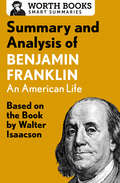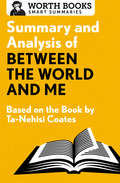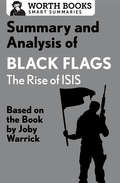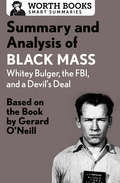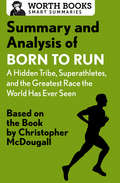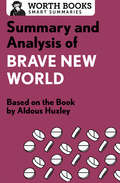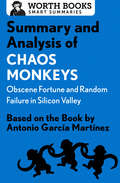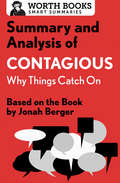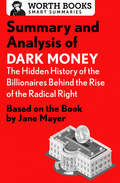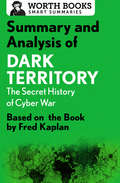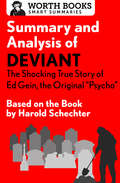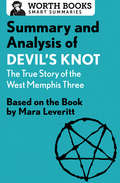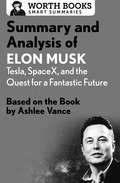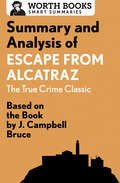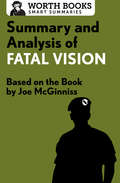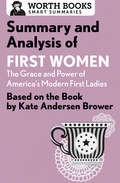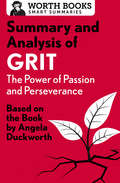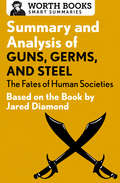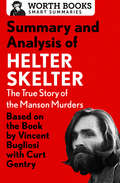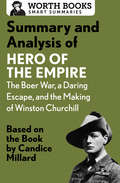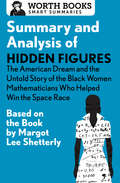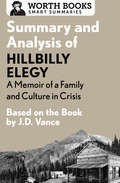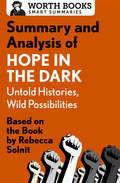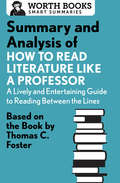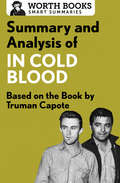- Table View
- List View
Summary and Analysis of Benjamin Franklin: Based on the Book by Walter Isaacson
by Worth BooksSo much to read, so little time? This brief overview of Benjamin Franklin tells you what you need to know—before or after you read Walter Isaacson’s book. Crafted and edited with care, Worth Books set the standard for quality and give you the tools you need to be a well-informed reader. This short summary and analysis of Benjamin Franklin by Walter Isaacson includes: Historical contextChapter-by-chapter overviewsCharacter profilesDetailed timeline of eventsImportant quotesFascinating triviaGlossary of termsSupporting material to enhance your understanding of the original work About Benjamin Franklin: An American Life by Walter Isaacson: In his thorough examination of one of America’s Founding Fathers, biographer Walter Isaacson explores the life and times of Benjamin Franklin and his legacy as a scientist, writer, diplomat, printing mogul, and voice for the common man. Isaacson follows Franklin from young runaway teenager in Philadelphia, to the savvy statesman coordinating the Franco-American alliance during the Revolutionary War, to the wise, 80-year-old politician at the Constitutional Convention. In between, we learn about Franklin the person—his complicated relationships, his scientific curiosity and brilliant discoveries, and the civic-mindedness that caused him to found a library, a fire department, a university, and a hospital. Franklin’s principles of democracy and admiration for the middle class continue to be at the foundation of American society. The summary and analysis in this ebook are intended to complement your reading experience and bring you closer to a great work of nonfiction.
Summary and Analysis of Between the World and Me: Based on the Book by Ta-Nehisi Coates
by Worth BooksSo much to read, so little time? This brief overview of Between the World and Me tells you what you need to know--before or after you read Ta-Nehisi Coates's book. Crafted and edited with care, Worth Books set the standard for quality and give you the tools you need to be a well-informed reader. This short summary and analysis of Between the World and Me by Ta-Nehisi Coates includes: Historical contextSection-by-section summariesThemes and symbolsDetailed timeline of key eventsImportant quotesFascinating triviaGlossary of termsSupporting material to enhance your understanding of the original work About Between the World and Me by Ta-Nehisi Coates: Written in the form of a letter to his young son, Ta-Nehisi Coates's National Book Award winner, Between the World and Me, is a powerful personal essay that addresses the history of racism in America and its impact on our lives today. Using his own experiences and observations as a starting point, Coates poses questions and imparts insights about the systematic oppression of persons of color, covering topics from the dark days of slavery to growing up in Baltimore in a "black body" to all-too-common instances of police brutality and everyday discrimination. The summary and analysis in this ebook are intended to complement your reading experience and bring you closer to a great work of nonfiction.
Summary and Analysis of Black Flags: Based on the Book by Joby Warrick
by Worth BooksSo much to read, so little time? This brief overview of Black Flags: The Rise of ISIS tells you what you need to know—before or after you read Joby Warrick’s book. Crafted and edited with care, Worth Books set the standard for quality and give you the tools you need to be a well-informed reader. This short summary and analysis of Black Flags includes: Historical contextChapter-by-chapter overviewsProfiles of the main charactersDetailed timeline of key eventsImportant quotesFascinating triviaGlossary of termsSupporting material to enhance your understanding of the original work About Black Flags: The Rise of ISIS by Joby Warrick: Two-time Pulitzer Prize winner Joby Warrick has written an authoritative account of the origins and rapid ascent of the largest global terrorist organization today: the Islamic State. Drawing on hundreds of interviews with US and Middle Eastern intelligence officials, as well as two decades of experience covering global terrorism, Warrick presents portraits of the group’s leadership, including the “godfather” of ISIS, Abu Musab al-Zarqawi, and of its current leader, Abu Bakr al-Baghdadi. Warrick explains the historical context and the sectarian struggles behind the rise of the Islamic State, the missteps by US intelligence that aided it, and the heroic work by intelligence and military officials that have fought against it. His work explains the appeal of ISIS and the threat it poses to the Middle East and global peace. The summary and analysis in this ebook are intended to complement your reading experience and bring you closer to a great work of nonfiction.
Summary and Analysis of Black Mass: Based on the Book by Dick Lehr and Gerard O'Neill (Smart Summaries)
by Worth BooksSo much to read, so little time? This brief overview of Black Masstells you what you need to know—before or after you read Dick Lehr and Gerard O&’Neill&’s book. Crafted and edited with care, Worth Books set the standard for quality and give you the tools you need to be a well-informed reader. This short summary and analysis of Black Mass by Dick Lehr and Gerard O&’Neill includes:Historical contextChapter-by-chapter summariesDetailed timeline of important eventsImportant quotesFascinating triviaSupporting material to enhance your understanding of the original work About Dick Lehr and Gerard O&’Neill&’s Black Mass: The New York Times–bestselling Black Mass is a groundbreaking true crime story about the Mafia, the FBI, and the Irish Mob in between them. Journalists Dick Lehr and Gerard O&’Neill expose a decades-long partnership between FBI agent John Connolly and notorious Boston mob boss Whitey Bulger. Connolly taps childhood friend-turned–Irish mobster Bulger to be an informant. But soon enough, Bulger is the one pulling the strings, convincing Connolly to cover up his dirty deeds. This corrupt deal results in a web of crimes including racketeering, drugs, and murder, all leading to an FBI rocked by scandal when the truth comes out. Shocking and enlightening, Black Mass is an Edgar Award–winning book that magnifies the fine line between law and lawlessness. The summary and analysis in this ebook are intended to complement your reading experience and bring you closer to a great work of nonfiction.
Summary and Analysis of Born to Run: Based on the Book by Christopher McDougall
by Worth BooksSo much to read, so little time? This brief overview of Born to Run tells you what you need to know—before or after you read Christopher McDougall’s book. Crafted and edited with care, Worth Books set the standard for quality and give you the tools you need to be a well-informed reader. This short summary and analysis of Born to Run by Christopher McDougall includes: Historical contextChapter-by-chapter overviewsDetailed timeline of key eventsImportant quotesFascinating triviaGlossary of termsSupporting material to enhance your understanding of the original work About Born to Run by Christopher McDougall: Christopher McDougall’s New York Times–bestselling Born to Run brought the underground sport of distance running to the forefront of American conversation, spurring trends like barefoot running and chia seeds’ recognition as a superfood. Centering around two long-distance races, the second of which McDougall intends to run, the book is written in a distinctly Gonzo journalism–style. The author focuses on the Tarahumara, an ancient tribe of runners that lives isolated in Mexico’s Copper Canyons, but he also pulls in plenty of other characters, past and present, and explores the biological reasons we are all born to run. The summary and analysis in this ebook are intended to complement your reading experience and bring you closer to a great work of nonfiction.
Summary and Analysis of Brave New World
by Worth BooksSo much to read, so little time? This brief overview of Brave New World tells you what you need to know—before or after you read Aldous Huxley’s book. Crafted and edited with care, Worth Books set the standard for quality and give you the tools you need to be a well-informed reader. This short summary and analysis of Brave New World includes: Historical context, Chapter-by-chapter overviews, Profiles of the main characters, Themes and symbols, Important quotes, Fascinating trivia, Glossary of terms, Supporting material to enhance your understanding of the original work. About Brave New World by Aldous Huxley: Aldous Huxley’s visionary Brave New World is one of the world’s greatest dystopian novels. In a society built on conformity, stability, and pervasive “happiness,” individuals are not born, but manufactured into one of five distinct castes—from dull-witted laborers to leaders and thinkers. Even as embryos, people are conditioned and programmed not only to accept, but to enjoy their predestined lives—or is it their slavery? But what happens when a savage—a man born from an actual mother—is introduced into this perfectly ordered society? Brave New World is a masterpiece of literary satire, as appropriate today, in our world of endless, shallow distractions and ubiquitous mass media, as it was when it was first published in 1932. The summary and analysis in this ebook are intended to complement your reading experience and bring you closer to a great work of fiction.
Summary and Analysis of Chaos Monkeys: Based on the Book by Antonio García Martinez
by Worth BooksSo much to read, so little time? This brief overview of Chaos Monkeys: Obscene Fortune and Random Failure in Silicon Valley tells you what you need to know—before or after you read Antonio García Martínez’s book. Crafted and edited with care, Worth Books set the standard for quality and give you the tools you need to be a well-informed reader. This short summary and analysis of Chaos Monkeys by Antonio García Martínez includes: Historical contextChapter-by-chapter overviewsCharacter profilesImportant quotesFascinating triviaGlossary of termsSupporting material to enhance your understanding of the original workAbout Chaos Monkeys: Obscene Fortune and Random Failure in Silicon Valley by Antonio García Martínez: Chaos Monkeys is an autobiographical account of Antonio García Martínez’s time in the exploding IT start-up scene in California, and his work as Facebook’s marketing manager. He offers a scathing and hilarious analysis of the landscape of contemporary social media. Based on his own experience and observations, Martínez unpacks the problems of funding and developing new tech companies, and the even greater problems of working for a large, up-and-coming corporation run by a visionary—who isn’t necessarily in it for the money. The summary and analysis in this ebook are intended to complement your reading experience and bring you closer to a great work of nonfiction.
Summary and Analysis of Contagious: Based on the Book by Jonah Berger
by Worth BooksSo much to read, so little time? This brief overview of Contagious tells you what you need to know—before or after you read Jonah Berger’s book. Crafted and edited with care, Worth Books set the standard for quality and give you the tools you need to be a well-informed reader. This short summary and analysis of Contagious includes: Historical contextChapter-by-chapter overviewsDetailed timeline of key eventsImportant quotesFascinating triviaGlossary of termsSupporting material to enhance your understanding of the original workAbout Contagious by Jonah Berger: Contagious: Why Things Catch On examines why certain media goes viral—videos, articles, memes—and others never get shared at all. By looking at popular culture, Wharton professor Jonah Berger analyzes what makes an idea take off. Based on his own research and the insights gleaned from 15 years of studying marketing, Berger’s New York Times–bestselling book teaches readers why popular content is popular, and how they can make their own ideas and products truly contagious. The summary and analysis in this ebook are intended to complement your reading experience and bring you closer to a great work of nonfiction.
Summary and Analysis of Dark Money: Based on the Book by Jane Mayer
by Worth BooksSo much to read, so little time? This brief overview of Dark Money tells you what you need to know—before or after you read Jane Mayer’s book. Crafted and edited with care, Worth Books set the standard for quality and give you the tools you need to be a well-informed reader. This short summary and analysis of Dark Money includes: Historical contextChapter-by-chapter overviewsProfiles of the main charactersDetailed timeline of key eventsImportant quotesFascinating triviaGlossary of termsSupporting material to enhance your understanding of the original workAbout Dark Money by Jane Mayer: Jane Mayer’s Dark Money: The Hidden History of the Billionaires Behind the Rise of the Radical Right tells the fascinating and troubling story of how a small group of activist billionaires has come to exert an enormous influence on American politics. By using their wealth to gain effective control of the Republican Party, Charles and David Koch have tied it to a conservative agenda that furthers their own business interests. Drawing on five years of carefully documented research, Jane Mayer, an investigative journalist and New Yorker staff writer, covers the family history of the Koch brothers and their decades-long journey from the fringes of right-wing politics to the very center of political power. Her message offers implicit warning about how anonymous, unlimited funding threatens to turn American politics into a government run by a few. The summary and analysis in this ebook are intended to complement your reading experience and bring you closer to a great work of nonfiction.
Summary and Analysis of Dark Territory: Based on the Book by Fred Kaplan
by Worth BooksSo much to read, so little time? This brief overview of Dark Territory: The Secret History of Cyber War tells you what you need to know—before or after you read Fred Kaplan’s book. Crafted and edited with care, Worth Books set the standard for quality and give you the tools you need to be a well-informed reader. This short summary and analysis of Dark Territory includes: Historical contextChapter-by-chapter overviewsProfiles of the main charactersDetailed timeline of key eventsImportant quotesFascinating triviaGlossary of termsSupporting material to enhance your understanding of the original workAbout Dark Territory by Fred Kaplan: Dark Territory traces the secret history of US intelligence in the Internet age and describes how cyberwarfare has evolved since the 1980s. Pulitzer Prize–winning journalist and Slate columnist Fred Kaplan reveals the major players, events, and technologies that have transformed the nature of war from being about bombs and bullets to bits and bytes. Although Edward Snowden brought it into the public spotlight, the National Security Agency’s operations have been involved in US and international policy for years through secret operations, espionage, and counterintelligence. Dark Territory is the covert and dangerous history of a war very few knew was being waged that continues to shape our future. The summary and analysis in this ebook are intended to complement your reading experience and bring you closer to a great work of nonfiction.
Summary and Analysis of Deviant: Based on the Book by Harold Schechter
by Worth BooksSo much to read, so little time? This brief overview of Deviant: The Shocking True Story of Ed Gein, the Original “Psycho” tells you what you need to know—before or after you read Harold Schechter’s book. Crafted and edited with care, Worth Books set the standard for quality and give you the tools you need to be a well-informed reader. This short summary and analysis of Deviant includes: Historical contextChapter-by-chapter overviewsProfiles of the main charactersDetailed timeline of key eventsImportant quotes and analysisFascinating triviaGlossary of termsSupporting material to enhance your understanding of the original workAbout Deviant: The Shocking True Story of Ed Gein, the Original “Psycho” by Harold Schechter: This true-crime classic profiles Ed Gein, the murderer and grave robber whose crimes inspired the films Psycho, The Silence of the Lambs, and The Texas Chainsaw Massacre. Ed Gein was a mildmannered midwestern farmhand—until his horrific crimes were uncovered. After a failed attempt to dig up the grave of his dead mother, Gein became a grave robber and then a murderer. What he did with the bodies of his victims was disturbing and gory beyond all imagination, and it leaves no doubt about what Ed Gein really was: the original psycho. The summary and analysis in this ebook are intended to complement your reading experience and bring you closer to a great work of nonfiction.
Summary and Analysis of Devil's Knot: Based on the Book by Mara Leveritt
by Worth BooksSo much to read, so little time? This brief overview of Devil’s Knot tells you what you need to know—before or after you read Mara Leveritt’s book. Crafted and edited with care, Worth Books set the standard for quality and give you the tools you need to be a well-informed reader. This short summary and analysis of Devil’s Knot by Mara Leveritt includes: • Historical context • Chapter-by-chapter summaries • Character profiles • Timeline of major events • Important quotes • Fascinating trivia • Supporting material to enhance your understanding of the original work About Mara Leveritt’s Devil’s Knot: The True Story of the West Memphis Three: In 1993, the brutal murders of three eight-year-old boys shocked the small town of West Memphis, Arkansas. Under pressure to solve the case, and lacking physical evidence to identify any suspects, authorities set their sights on a local trio of misfit teenagers, Damien Echols, Jason Baldwin, and Jessie Misskelley, later dubbed the West Memphis Three. Leveritt’s account of the case, which resulted in one death sentence and two life sentences, is by turns a shocking, appalling, and heartbreaking work of true crime writing. Likening the Three’s plight to the Salem Witch Trials, she calls America’s justice system into question, arguing that these three young men were condemned simply for being different. The summary and analysis in this ebook are intended to complement your reading experience and bring you closer to a great work of nonfiction.
Summary and Analysis of Elon Musk: Based on the Book by Ashlee Vance (Smart Summaries)
by Worth BooksSo much to read, so little time? This brief overview of Elon Musk tells you what you need to know—before or after you read Ashlee Vance&’s book. Crafted and edited with care, Worth Books set the standard for quality and give you the tools you need to be a well-informed reader. This short summary and analysis of Elon Musk includes: Historical contextChapter-by-chapter overviewsProfiles of the main charactersDetailed timeline of key eventsImportant quotesFascinating triviaGlossary of termsSupporting material to enhance your understanding of the original work About Elon Musk: Tesla, SpaceX, and the Quest for a Fantastic Future by Ashlee Vance: The bestselling biography Elon Musk offers a vigorous look at the most famous entrepreneur of our time. Ashlee Vance&’s tough reporting, exclusive access to Musk&’s friends and family, and years on the technology beat for Bloomberg Businessweek have enabled him to paint a picture of the most interesting man in the industry. Elon Musk is behind the modern electric vehicle at Tesla and has revolutionized the cost and convenience of spaceflight at his rocket company, SpaceX. In addition to these major business and technological success stories, Musk cofounded PayPal, which was sold to eBay for $1.5 billion, and sold Zip2 to Compaq during the dotcom boom. The summary and analysis in this ebook are intended to complement your reading experience and bring you closer to a great work of nonfiction.
Summary and Analysis of Escape from Alcatraz: Based on the Book by J. Campbell Bruce
by Worth BooksSo much to read, so little time? This brief overview of Escape from Alcatraz tells you what you need to know—before or after you read J. Campbell Bruce’s book. Crafted and edited with care, Worth Books set the standard for quality and give you the tools you need to be a well-informed reader. This short summary and analysis of Escape from Alcatraz by J. Campbell Bruce includes: Historical contextChapter-by-chapter summariesImportant quotesFascinating triviaGlossary of termsSupporting material to enhance your understanding of the original work About Escape from Alcatraz by J. Campbell Bruce: A true crime classic, Escape from Alcatraz recounts the history of the infamous prison on Alcatraz Island and the many men who risked their lives trying to escape it. Bruce’s book brings to life the grim, gruesome conditions of life in lockup on Alcatraz, and the prisoners who lived there—from notorious gangster Al “Scarface” Capone to robber Frank Lee Morris, the architect of Alcatraz’s most audacious escape. More than a tale of prison break, Escape from Alcatraz is a scathing indictment of a penal system that strives for dehumanization, rather than rehabilitation, of its prisoners. The summary and analysis in this ebook are intended to complement your reading experience and bring you closer to a great work of nonfiction.
Summary and Analysis of Fatal Vision: Based on the Book by Joe McGinniss
by Worth BooksSo much to read, so little time? This brief overview of Fatal Vision tells you what you need to know before or after you read Joe McGinniss’s book. Crafted and edited with care, Worth Books set the standard for quality and give you the tools you need to be a well-informed reader. This short summary and analysis of Fatal Vision by Joe McGinniss includes: Historical contextSection-by-section overviewsDetailed timeline of key eventsImportant quotesFascinating triviaGlossary of termsSupporting material to enhance your understanding of the original work About Joe McGinniss’s Fatal Vision: In 1970, the country was gripped by a brutal triple-murder at Fort Bragg, North Carolina. Colette MacDonald, then pregnant, and her two young daughters were beaten and stabbed to death in their home. The prime suspect was Colette’s husband, a charismatic military doctor and Green Beret named Jeffrey MacDonald. MacDonald invited writer Joe McGinniss to write a book about the case. Fatal Vision, published in 1983, has become a true crime classic, but not without controversy. In 1984, MacDonald sued McGinniss for fraud, claiming he misrepresented his intentions, making Fatal Vision an incredibly compelling story and an excellent example of the complex questions surrounding free speech and journalistic integrity. The summary and analysis in this ebook are intended to complement your reading experience and bring you closer to a great work of nonfiction.
Summary and Analysis of First Women: Based on the Book by Kate Andersen Brower (Smart Summaries)
by Worth BooksSo much to read, so little time? This brief overview of First Women:The Grace and Power of America&’s Modern First Ladies tells you what you need to know—before or after you read Kate Andersen Brower&’s book. Crafted and edited with care, Worth Books set the standard for quality and give you the tools you need to be a well-informed reader. This short summary and analysis of First Women includes: Historical contextChapter-by-chapter overviewsProfiles of the main charactersDetailed timeline of key eventsImportant quotesFascinating triviaGlossary of termsSupporting material to enhance your understanding of the original workAbout First Women by Kate Andersen Brower: The wife of the president of the United States is inevitably in the spotlight, her every move scrutinized—especially in the modern age of mass media. All eyes are on the First Lady. But how well do we really know these women—their passions, their priorities, their personalities, and the power they wield in public and in private? Political journalist Kate Andersen Brower presents nuanced and enlightening portraits of ten modern First Ladies, from Jacqueline Kennedy to Melania Trump. Learn about their tenure in the White House, motherhood and diplomacy in Washington, and their complex relationships—with their husbands, with one another, and with their staffers. The summary and analysis in this ebook are intended to complement your reading experience and bring you closer to a great work of nonfiction.
Summary and Analysis of Grit: Based on the Book by Angela Duckworth (Smart Summaries)
by Worth BooksSo much to read, so little time? This brief overview of Grit tells you what you need to know—before or after you read Angela Duckworth&’s book. Crafted and edited with care, Worth Books set the standard for quality and give you the tools you need to be a well-informed reader. This short summary and analysis of Grit by Angela Duckworth includes: Historical contextChapter-by-chapter summariesImportant quotesFascinating triviaGlossary of termsSupporting material to enhance your understanding of the original work About Angela Duckworth&’s Grit: Psychologist Angela Duckworth blows the lid off of theories that suggest IQ and socioeconomic status are the sole predictors of success. Not intellectually gifted, according to her traditional, Asian-American father, Duckworth nevertheless became a MacArthur &“Genius.&” Winning the award led her to reflect upon the qualities that got her there: perseverance and passion. Interviewing dozens of the world&’s winners, Duckworth ventures into the playing fields of achievement, speaking with CEOs and coaches, and visits West Point, competitive swim teams, and even the National Spelling Bee to discover the common threads. Pulling from history, as well as cutting-edge neuroscience and behavioral science, Grit offers tips and advice for everyone—from parents to athletes to entrepreneurs—about how getting gritty can help you to succeed. The summary and analysis in this ebook are intended to complement your reading experience and bring you closer to a great work of nonfiction.
Summary and Analysis of Guns, Germs, and Steel: Based on the Book by Jared Diamond
by Worth BooksSo much to read, so little time? This brief overview of Guns, Germs, and Steel tells you what you need to know--before or after you read Jared Diamond's book. Crafted and edited with care, Worth Books set the standard for quality and give you the tools you need to be a well-informed reader. This short summary and analysis of Guns, Germs, and Steel by Jared Diamond includes: Historical contextChapter-by-chapter summariesDetailed timeline of key eventsImportant quotesFascinating triviaGlossary of termsSupporting material to enhance your understanding of the original work About Guns, Germs, and Steel by Jared Diamond: Professor Jared Diamond's informative and fascinating Pulitzer Prize-winning Guns, Germs, and Steel explores a historic question: Why were the Eurasian peoples able to dominate those from other lands? Diamond argues that it was ecology and geography--not race--that shaped the modern world. Societies that developed in regions with fertile land for farming and that had domesticable plants and animals were able to progress more quickly, thereby creating the tools to conquer preliterate cultures. Drawing on a variety of disciplines--from linguistics, genetics, and epidemiology to biology, anthropology, and technology--Guns, Germs, and Steel offers an eloquently argued view of the development of human societies. The summary and analysis in this ebook are intended to complement your reading experience and bring you closer to a great work of nonfiction.
Summary and Analysis of Helter Skelter: Based on the Book by Vincent Bugliosi with Curt Gentry (Smart Summaries)
by Worth BooksSo much to read, so little time? This brief overview of Helter Skelter tells you what you need to know—before or after you read Vincent Bugliosi and Curt Genry&’s book. Crafted and edited with care, Worth Books set the standard for quality and give you the tools you need to be a well-informed reader. This summary of Helter Skelter by Vincent Bugliosi with Curt Gentry includes: Historical contextSection-by-section overviewsDetailed timeline of eventsAnalysis of the main charactersFascinating triviaGlossary of termsSupporting material to enhance your understanding of the original work About Vincent Bugliosi and Curt Gentry&’s Helter Skelter: In the bestselling true crime book Helter Skelter, lead prosecutor Vincent Bugliosi provides a meticulously detailed account of the murders committed by the Manson family and their trial—one of the most sensational criminal cases of the century. From the police investigation of the murders of Leno and Rosemary LaBianca and Sharon Tate, to the arrests, the courtroom antics, and the personalities and motivations of Charles Manson and his followers, Helter Skelter offers a haunting look into the horrific repercussions of cult mentality on a violent rampage. The summary and analysis in this ebook are intended to complement your reading experience and bring you closer to a great work of nonfiction.
Summary and Analysis of Hero of the Empire: Based on the Book by Candice Millard
by Worth BooksSo much to read, so little time? This brief overview of Hero of the Empire tells you what you need to know—before or after you read Candice Millard’s book. Crafted and edited with care, Worth Books set the standard for quality and give you the tools you need to be a well-informed reader. This short summary and analysis of Hero of the Empire includes: Historical contextChapter-by-chapter overviewsProfiles of the main charactersTimeline of key eventsImportant quotesFascinating triviaGlossary of termsSupporting material to enhance your understanding of the original work About Hero of the Empire: The Boer War, a Daring Escape, and the Making of Winston Churchill by Candice Millard: Winston Churchill is a towering figure of the 20th century, but Candice Millard focuses on a much younger Churchill, whose unexpected adventures and heroics helped make him into the charismatic leader he is rememered as. With a trove of period details, a colorful cast of characters, and a deep feeling for 19th-century history, Millard’s biography recounts Churchill’s early military adventures before and during the Boer War. She then puts readers in the middle of that brutal conflict along with a young Churchill, as he rushes toward the daring escape that would bring him the admiration of the British Empire and the beginning of his legendary political career. The summary and analysis in this ebook are intended to complement your reading experience and bring you closer to a great work of nonfiction.
Summary and Analysis of Hidden Figures: Based on the Book by Margot Lee Shetterly (Smart Summaries)
by Worth BooksSo much to read, so little time? Get an overview of Hidden Figures, the true story about the African American female mathematicians who helped NASA win the space race. Margot Lee Shetterly&’s Hidden Figures tells the incredible real-life account of Dorothy Vaughan, Mary Jackson, Katherine Johnson, and Christine Darden—who, in a time when black women faced seemingly insurmountable obstacles, went to work as &“calculators&” at NASA. With pencils, paper, and slide rules, they transformed airplane, rocket, and satellite designs—and ensured a World War II victory. Despite the social and political climate at the height of Jim Crow, these women rose up and became integral to the project that put the first man on the moon. From World War II to the Cold War to the civil rights movement to the space race, Hidden Figures tells the story of four remarkable women whose contributions to science led to some of NASA&’s greatest successes. The book has become a New York Times bestseller as well as a Screen Actors Guild Award–winning and Academy Award–nominated picture starring Taraji P. Henson, Octavia Spencer, Kirsten Dunst, and Kevin Costner. With historical context, important quotes, fascinating trivia, a glossary of terms, and other features, this summary and analysis of Hidden Figures: The American Dream and the Untold Story of the Black Women Mathematicians Who Helped Win the Space Race is intended to complement your reading experience and bring you closer to a great work of nonfiction.
Summary and Analysis of Hillbilly Elegy: Based on the Book by J.D. Vance (Smart Summaries)
by Worth BooksSo much to read, so little time? This brief overview of Hillbilly Elegy tells you what you need to know—before or after you read J.D. Vance&’s book. Crafted and edited with care, Worth Books set the standard for quality and give you the tools you need to be a well-informed reader. This short summary and analysis of Hillbilly Elegy includes: Historical contextChapter-by-chapter overviewsCharacter profilesImportant quotesFascinating triviaGlossary of termsSupporting material to enhance your understanding of the original work About Hillbilly Elegy: A Memoir of a Family and Culture in Crisis by J.D. Vance: Hillbilly Elegy is both an honest, heartbreaking memoir about what it&’s really like to grow up in poverty and strife and a searing, thought-provoking take on the growing class divide in America. Hillbilly Elegy touches on how, as a country, we got here—and what, must be done to reverse the damage. As Ivy League–educated lawyer and Sillicon Valley principal J.D. Vance looks back on his childhood in Jackson, Kentucky, and Ohio, he recalls a youth marred by violence, poverty, and substance abuse, but also one of deep love and family loyalty. He tackles difficult questions about social class, upward mobility, and what it means to feel disenfranchised in your own country. His highly personal account guides readers to an understanding of rural conservatives, and how an entire segment of people transformed from New Deal democrats to right-wing Republicans. The summary and analysis in this ebook are intended to complement your reading experience and bring you closer to a great work of nonfiction.
Summary and Analysis of Hope in the Dark: Based on the Book by Rebecca Solnit
by Worth BooksSo much to read, so little time? This brief overview of Hope in the Dark tells you what you need to know—before or after you read Rebecca Solnit’s book. Crafted and edited with care, Worth Books set the standard for quality and give you the tools you need to be a well-informed reader. This short summary and analysis of Hope in the Dark includes: Historical contextChapter-by-chapter overviewsProfiles of the main charactersDetailed timeline of eventsImportant quotes and analysisFascinating triviaGlossary of termsSupporting material to enhance your understanding of the original workAbout Hope in the Dark: Untold Histories, Wild Possibilities by Rebecca Solnit: Written in response to the 2004 US presidential election, and updated during the 2016 race, Rebecca Solnit’s Hope in the Dark is a call to action for people who find themselves despairing about the political climate of the world today. Hope in the Dark is a long essay that serves as a primer on social and environmental activism and uprisings from the mid-to-late 20th century to the present. Solnit uses this history of protesters, writers, and workers to argue that hope is the necessary catalyst for action. She insists that radicals and revolutionaries must hold onto hope in order to create a world more like the one they want to live in, even in the face of enormous obstacles, and especially in the face of uncertainty. The summary and analysis in this ebook are intended to complement your reading experience and bring you closer to a great work of nonfiction.
Summary and Analysis of How to Read Literature Like a Professor: Based on the Book by Thomas C. Foster (Smart Summaries)
by Worth BooksSo much to read, so little time? This brief overview of How to Read Literature Like a Professor tells you what you need to know—before or after you read Thomas C. Foster&’s book. Crafted and edited with care, Worth Books set the standard for quality and give you the tools you need to be a well-informed reader. This summary of How to Read Literature Like a Professor by Thomas C. Foster includes: Historical contextChapter-by-chapter overviewsImportant quotesFascinating triviaA glossary of termsSupporting material to enhance your understanding of the original work About How to Read Literature Like a Professor by Thomas C. Foster: Thomas C. Foster&’s How to Read Literature Like a Professor is a series of short essays that show readers how to &“read between the lines&” and make great books come alive. Based on Professor Foster&’s years as a teacher of literature, Foster explains how authors use the English language to accomplish their goals and how we can recognize literary ideas in a wide range of works. The tools he offers can be applied to any book—from the classics to the latest blockbusters. The summary and analysis in this ebook are intended to complement your reading experience and bring you closer to a great work of nonfiction.
Summary and Analysis of In Cold Blood: A True Account of a Multiple Murder and Its Consequences
by Worth BooksSo much to read, so little time? This brief overview of In Cold Blood tells you what you need to know—before or after you read Truman Capote’s book. Crafted and edited with care, Worth Books set the standard for quality and give you the tools you need to be a well-informed reader. This short summary and analysis of In Cold Blood by Truman Capote includes: Historical context, Chapter-by-chapter summaries, Detailed timeline of important events, Important quotes, Fascinating trivia, Supporting material to enhance your understanding of the original work. About Truman Capote’s In Cold Blood: A masterpiece of true crime and literary nonfiction, Truman Capote’s In Cold Blood is the story of a 1959 multiple murder in rural Kansas. Combining journalistic research with masterful storytelling, Capote reconstructs the events surrounding the killing of the Clutter family and the crime’s aftermath—from the last day of the Clutters’ lives to the day their murderers are executed. Gripping, chilling, and suspenseful, In Cold Blood is a pioneering work of nonfiction and a highly acclaimed modern American classic. The summary and analysis in this ebook are intended to complement your reading experience and bring you closer to a great work of nonfiction.
